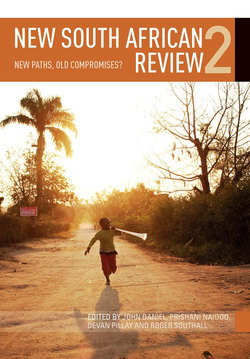Читать книгу New South African Review 2 - Paul Hoffman - Страница 16
На сайте Литреса книга снята с продажи.
CHAPTER 1 The Tripartite Alliance and its discontents: Contesting the ‘National Democratic Revolution’ in the Zuma era
ОглавлениеDevan Pillay
Despite increasingly shrill public spats between alliance partners since the 2009 elections, was John Kane-Berman, head of the South African Institute of Race Relations, correct to suggest that ‘staying in the alliance was the better strategy to push the political centre of gravity of the African National Congress (ANC) further to the left’ (Business Day, 31 January 2011)? Kane-Berman was lamenting the influence of the Congress of South African Trade Unions (Cosatu) over impending labour legislation, but his fears chimed with broader concerns from within the business community regarding future economic policy. Government’s New Growth Path, launched in October 2010, suggests greater state intervention in the economy, and calls for the nationalisation of sectors of the economy are growing within the ANC.
Left critics, by contrast, argue that the alliance, through its National Democratic Revolution (NDR) ideological discourse, fulfils an important legitimating function. It glues together disparate social classes under the hegemony of conservative class interests – a coalition of white and emerging comprador black capital (enmeshed in ever-expanding networks of patronage and corruption), and a professional black middle class that has done rather well out of the post-apartheid dispensation. In other words, the organised working class are being deceived – by their leadership, also implicated in patronage politics – into supporting the ANC against their own class interests, and some believe that the time has come to build a ‘left opposition’ outside the alliance.
The alliance left, however, insist that since Jacob Zuma assumed the leadership of the ANC at the December 2007 Polokwane conference, space has opened for further contestation within the ANC and the government. To leave the alliance and build a left opposition outside it would, on the one hand, abandon that space to predatory right-wing forces and, on the other, relegate the left to the political fringe, no more than what ANC general secretary and SA Communist Party (SACP) chair-person Gwede Mantashe calls a ‘debating society’.1
Alliance supporters also argue that, despite slow progress towards reducing inequality and eradicating poverty, the alliance remains essential to holding the centre together by preserving national coherence through an increasingly tension-ridden but nevertheless persistent ‘nonracial’ discourse, and preventing South Africa from splitting into a dangerously fractious contest over resources. The working class understand that this is in their interests and are influencing their leadership in the unions and SACP, as much as leadership is influencing them.
In other words, despite its class biases and its acknowledged ‘sins of incumbency’, is the ANC Alliance the only hope for setting the country on an inclusive developmental path? Or does there need to be greater political uncertainty, credible electoral challenges from the left (or, for liberal pluralists, from the right as well) to prevent the ruling party from taking citizens for granted? Indeed, are the two mutually exclusive?
This chapter examines the state of the alliance since the 2007 Polokwane national congress of the ANC, but within the context of the movement’s powerful discourse on the national democratic revolution which first emerged in the 1920s. It then considers the various events since the 2007 Polokwane conference that seemingly threaten the stability of the alliance, a recent survey of Cosatu members’ political attitudes and, briefly, an attempt by ousted SACP officials and independent socialists to build an alternative pole of attraction outside the alliance.
